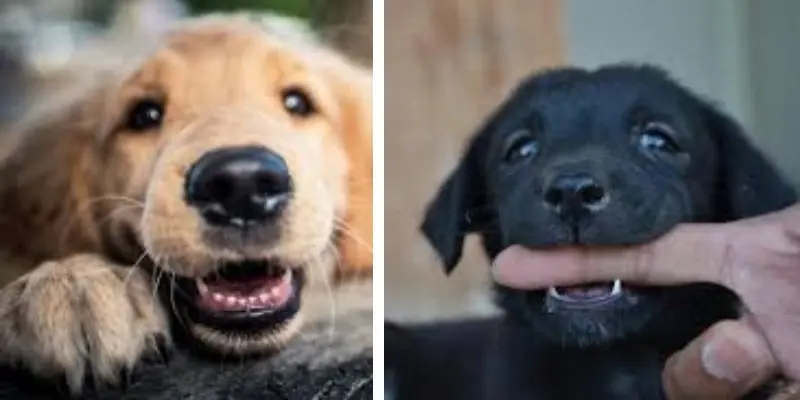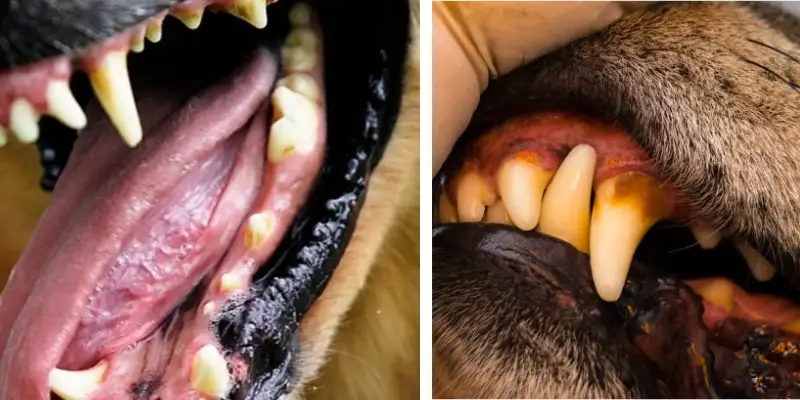Labrador Teeth Facts – Signs, Stages, and Solutions
Published: 01 Jan 2025
Do you know how Labrador Retrievers maintain their playful nature and love for fetch year after year? Don’t be surprised—it all starts with their teeth! Whether they have tiny puppy teeth or powerful adult teeth, Labradors, like all other dogs, rely on their dental health to help them play, chew, and retrieve.
But imagine what happens when the teeth aren’t properly cared for? Just like humans, dogs also go through a teething process and need proper dental care to stay healthy and playful.
In this post, we will cover everything you need to know about Labrador teeth and why maintaining them is crucial.
The Basics of Labrador Teeth

Theeting Cycle
Like all other dogs, they have two sets of teeth in their lifetime. The first set, which is called puppy teeth, comes in when they are just a few weeks old. These small, sharp teeth help them explore the world by chewing on toys and other objects. Around 4 to 6 months, these puppy teeth start falling out, making way for adult teeth.
An adult Labrador has a full set of 42 teeth. These teeth are strong and designed for chewing and holding onto things, which makes them excellent retrievers. Their teeth include incisors (in the front), canines (pointy teeth), and molars (at the back) to help with grinding food.
Fun fact: Just like us, Regular brushing, dental chews, and vet visits can help keep their teeth healthy for years.
Labrador Teething: What to Expect
Labrador puppies start teething at around 3 weeks(called milk teeth). These milk teeth are fully grown by 6-8 weeks of age.
By the age of 4-5 months, their baby teeth begin to fall out, and adult teeth start showing up. This teething can cause some discomfort in the gums, but it’s a natural part of growing up. During this time, your puppy might chew on everything in sight—shoes, furniture, toys, you name it!
You’ll likely notice your puppy drooling more, and their gums might be a little red or swollen. Don’t worry, this is just a sign that their adult teeth are coming in. To help ease the pain, provide them with teething toys that are safe to chew on. Rubber or nylon toys are great because they’re durable and won’t break apart easily.
Tip: If your puppy is chewing on things you don’t want them to, redirect them to a chew toy instead (this will also lay a foundation for following commands). With a little patience, your Labrador will get through this stage and have a full set of adult teeth ready to go!
Common Dental Problems in Labradors
Just like humans, Labradors can face dental problems if their teeth aren’t taken care of properly. Some of the most common issues include tartar buildup, gum disease, and bad breath.
Tartar Build-up: Over time, plaque can harden on your Labrador’s teeth and turn into tartar. This can cause the gums to become irritated and even lead to tooth decay. Brushing their teeth at least twice a week can help control tartar, but if you see a serious buildup, a professional cleaning from a vet might be needed.
Gum Disease: If tartar isn’t treated, it can lead to gum disease, which is common in many dogs, including Labradors. Symptoms include swollen, red gums that may bleed when touched. This can cause pain and difficulty eating, so it’s important to catch it early.

Bad Breath: While dogs naturally have a bit of “doggy breath,” bad breath that doesn’t go away could be a sign of a dental problem. If you notice your Labrador’s breath smells worse than usual, a trip to the vet. It may be caused by tartar, gum disease, or even tooth infections.
Prevention Tip: To avoid these dental issues, brush your Labrador’s teeth regularly and provide them with dental chews or toys. Regular vet check-ups are also important to catch any problems early.
How to Care for Your Labrador’s Teeth
Here are some simple and effective tips to care for your Labrador’s teeth:

1. Brush Their Teeth Regularly:
Use a dog-safe toothbrush and toothpaste, as human toothpaste can be harmful to dogs. Aim to brush your dog’s teeth at least 2-3 times a week to remove plaque and prevent tartar buildup.
2. Provide Dental Chews:
Look for chews that are specifically designed to help remove tartar. These chews can be a fun and tasty way to keep your dog’s mouth healthy.
3. Offer Safe Chew Toys:
Choose durable, safe toys that can withstand their chewing. Avoid toys that can easily break into pieces, as small parts of broken toys can be a choking.
4. Feed a Balanced Diet:
Avoid feeding them too many treats that could stick to their teeth and cause problems.
5. Regular Vet Check-ups:
Professional cleanings may be necessary from time to time to keep their teeth in tip-top shape.
By following these tips, you can help keep your Labrador’s teeth healthy and strong, ensuring they stay happy and pain-free for years to come!
Warning Signs For Labrador Dental Problems
Here are some warning signs to look out for:
1. Difficulty Eating:
If you notice them chew on one side of their mouth, avoid certain types of food, or even refuse to eat their meals. This could be a sign of tooth pain or gum irritation.
2. Excessive Drooling:
While some drooling is normal, excessive drooling can indicate that your dog’s teeth or gums are bothering them. If your Labrador is drooling more than usual, especially while eating, it’s worth checking their teeth and gums.
3. Pawing at the Mouth or Face:
If your Labrador is constantly pawing at their mouth or rubbing their face, it could be a sign that their teeth or gums are hurting. This behavior is often a sign of discomfort.
4. Swollen or Bleeding Gums:
Healthy gums are pink and firm. If your Labrador’s gums are swollen, red, or bleeding, it could indicate gum disease or an infection, which can lead to more serious issues if not treated in time.
If you notice any of these signs, it’s important to take your Labrador to the vet for a dental check-up. Catching dental problems early can help prevent more serious issues down the road.
How to Handle Labrador’s Dental Emergencies
Dental emergencies can happen, even with the best care. As a dog owner, it’s important to know how to react in case your Labrador experiences a dental emergency. Here’s what you can do if you find yourself in this situation:
- Stay Calm: It’s important to stay calm so you can handle the situation clearly and efficiently.
- Contact Your Vet: In most cases, dental issues should be addressed by a veterinarian as soon as possible to avoid complications.
- Avoid Home Remedies: Never try to fix a dental problem at home. Trying to remove a tooth or treat an injury yourself could cause more harm.
Dental emergencies can be scary, but with quick action and the right care, you can help your Labrador get back on track to a healthy, happy smile.
Faqs.
Adult Labradors typically have 42 teeth—20 on the upper jaw and 22 on the lower jaw. Puppies have fewer teeth, around 28, which are replaced by adult teeth as they grow.
Labrador puppies usually start losing their baby teeth at around 3-4 months old. By 6-7 months, most Labs have their full set of adult teeth.
A slight doggy smell is normal, but strong bad breath isn’t. It’s often a sign of dental problems like tartar buildup, gum disease, or even an infection. If the bad breath is persistent, consult your vet.
While cavities are rare in dogs, Labradors can still experience tooth decay, especially if their diet is high in sugar or if dental care is neglected. Regular brushing and dental chews can help prevent this.
Excessive drooling can be a sign of dental pain or issues like an abscess, infection, or something stuck in their teeth. If you notice this, check their mouth and contact your vet.
Signs of dental pain include difficulty eating, pawing at the mouth, excessive drooling, or avoiding hard food and toys.
The best way is regular brushing with a dog-safe toothpaste. You can also use dental wipes, gels, or sprays for extra cleaning. Combine this with dental chews for the best results.
Yes, vets use special tools to clean your Labrador’s teeth thoroughly, preventing gum disease and other problems.
Tail End Thoughts
Your Labrador’s teeth play a crucial role in their overall health, from puppy teething to strong adult jaws. Understanding the stages of their dental development helps you spot signs of trouble early. Regular brushing, vet check-ups, and the right chew toys can prevent common dental issues.
A healthy mouth means a happy, active Lab! Stay proactive, and your furry friend will enjoy a lifetime of tail wags and bright smiles.





